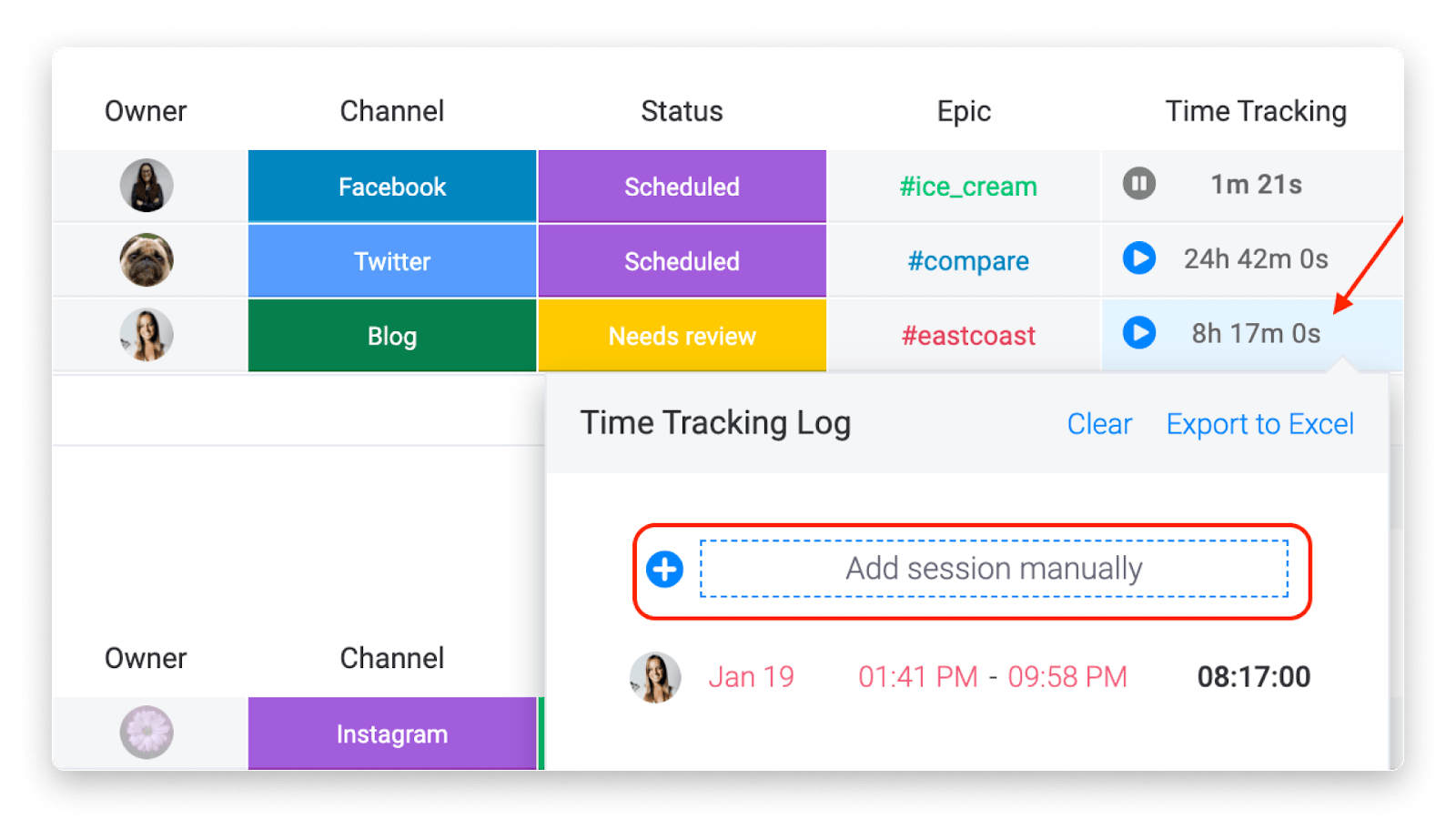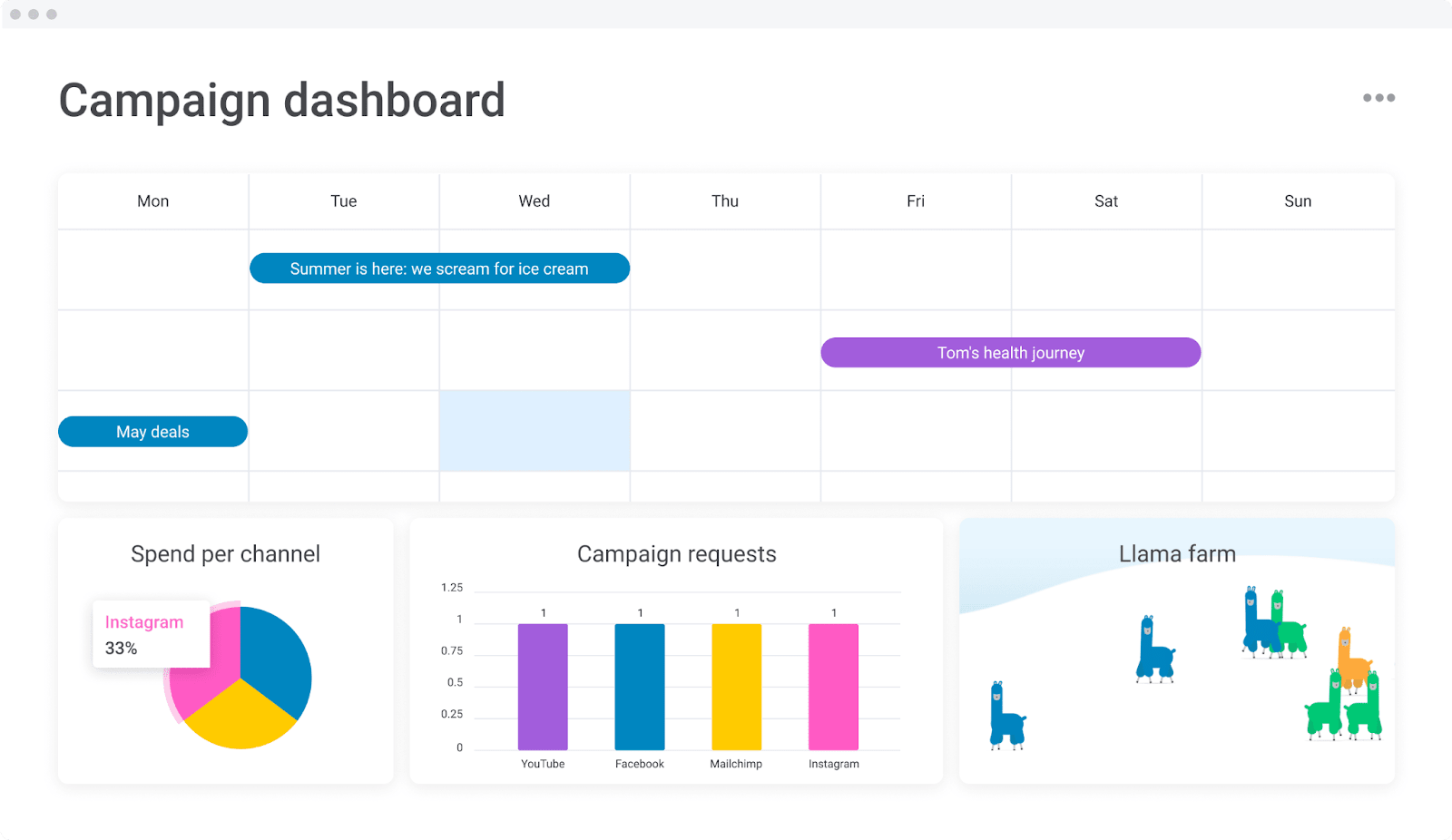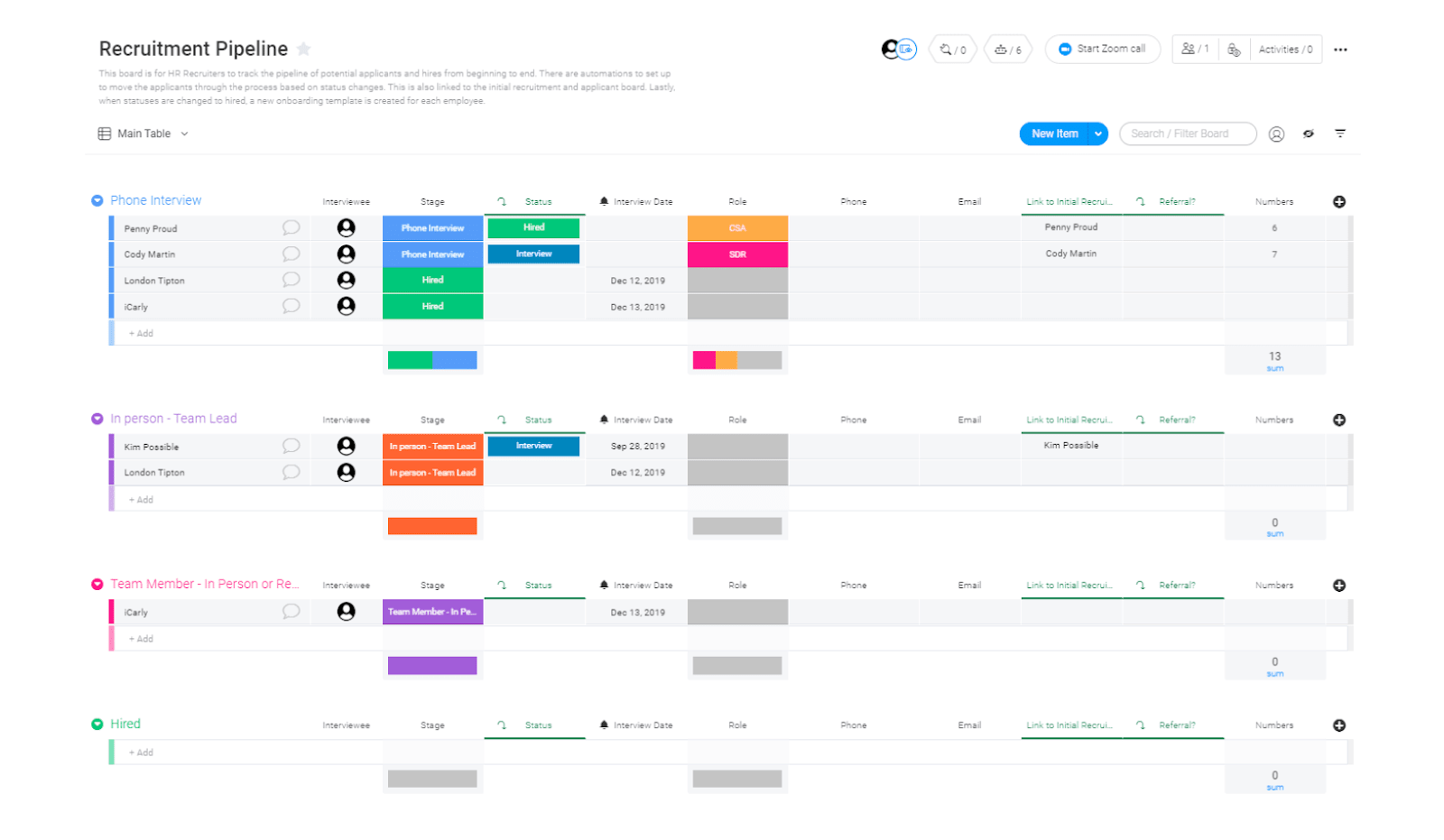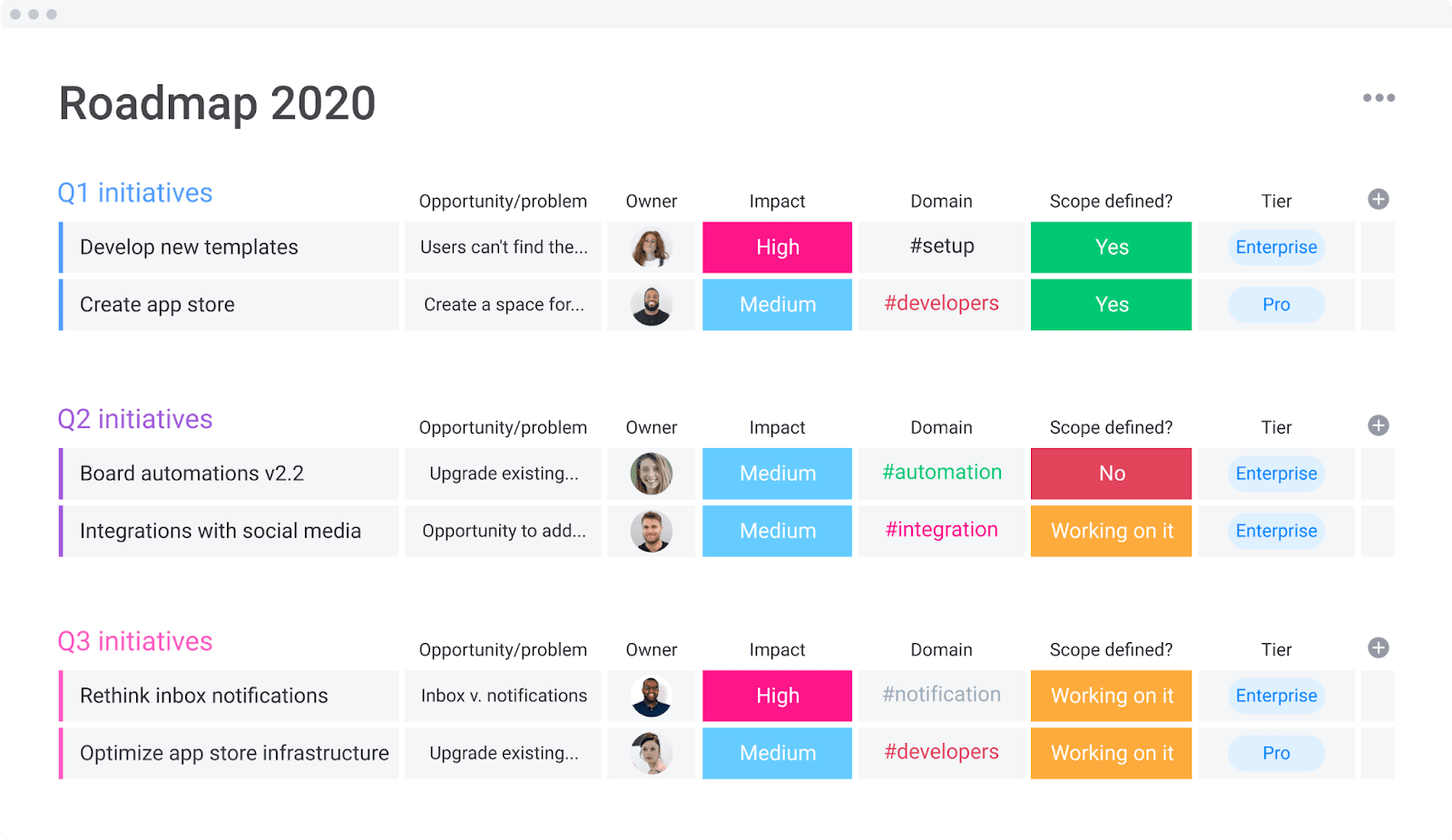Last year, the slow shift to a remote work economy accelerated drastically.
Businesses had to overcome several challenges unique to working as remote teams — one of the most pressing being successfully tracking time.
But whether your business works remotely or in a physical office, time-tracking software solutions offer plenty of advantages for everyone.
In this article, we’ll go over the benefits of tracking your time and explain why you should do so with time-tracking apps instead of paper timesheets.
We’ll also explore some features you should look for in your time-tracking software, and show you how to create your own time-tracking solution with monday.com.
What is a time-tracking app?
A time-tracking app is a type of software solution that lets you log the time you spend working on tasks and projects.
Time-tracking apps can be standalone products, integrated within other programs such as a task manager app or a clock app, or custom-built apps within a larger platform, such as monday.com.If it’s a standalone solution, it may be either a desktop app or a web app. Most also offer an iOS and Android app for time tracking on your mobile device, while some even provide a browser extension if needed.
What is a time tracking app used for?
Tracking time is critical for a variety of reasons.
For one, it’s fundamental to getting paid correctly. Hourly workers need to make sure they get the right pay for regular hours, overtime, and so on.
Meanwhile, freelancers and professional services firms need to ensure they bill clients appropriately for the time spent on projects.
Tracking time is also helpful for remote workers who want to monitor productivity and avoid working too much. About 41.8% of the workforce is fully remote — with that number likely to continue growing — making accurate time-tracking all the more critical.
Additionally, freelancers may track their time throughout the workday and week to compare their total earnings against hours worked to arrive at their effective hourly rate. That way, they can make decisions about their rates and desired workload.
Given its multiple uses, time-tracking software is often thought of as a mix between a clock app and a productivity app.
Reasons to track your time with a time-tracking app
It’s time to ditch the paper timesheets. Here are several advantages to tracking your time with software.
Saves time on attendance and time tracking
Manual timesheets aren’t very efficient. You and your team have to spend extra time recording time instead of working on mission-critical projects.
Time tracking software often comes with real-time time tracking in the form of stopwatch buttons that you simply press to start and stop.
Some apps can also tell when you start and stop work based on interactions with your computer.
Regardless, everyone saves a few extra minutes logging their time — which adds up over months and years.
Then, you can generate reports instantly based on recorded time data.
Fewer errors
Manual timesheets aren’t completely reliable. Someone may record incorrect working hours, whether by forgetting and guessing their hours, errors in writing, or even outright lying.
These errors can lead to plenty of problems, such as employees and contractors not receiving proper pay, undercharging — or overcharging — clients/customers for work, and getting inaccurate data on time spent for each project.
Time-tracking solutions solve this issue because you no longer have to record the work hours yourself.
As long as you start and stop the time tracker correctly, things should be accurate every time. Plus, you can go in and make edits manually in many cases.
Better billing
Some time-tracking applications even have invoicing features built-in. These programs often let you automatically create invoices based on hours tracked.
Thanks to this built-in invoicing functionality, you can streamline your billing process and put more time toward actual productive work.
Simultaneously, it ensures that you get paid what your work is worth.
Once again, time tracking reports let you verify numbers, just in case.
Helps with resource allocation and process improvement
Tracking time gives you insight into how long various tasks and projects take. This allows you to allocate resources better to complete more projects on time and on budget.
If you find your team is taking too long on a specific task, you can assign more people to that task.
You could also track time alongside something like this Resource Allocation template for faster decision-making.

It’s a similar story for process improvement.
Use your time tracking tool to record how long every task or process step takes. You can then try and find ways to simplify and streamline.
What should I look for in time-tracking software?
Time-tracking software sounds simple enough. At the bare minimum, your app should make it easy to keep track of your hours worked.
However, there are plenty of other features to look for in a time-tracking app that can enhance productivity.
Here are a few to prioritize in your search.
Real-time time tracking
A good time-tracking app will never force you to keep track of hours in your head, just to log them later. That inefficiency just creates many of the same issues that plague paper timesheets.
Instead, it should give you a button or toggle to start and stop time tracking.
Notice that 2 tasks are paused while one task is tracking time in this example from monday.com.
![]()
As mentioned, some programs can even tell when to start and stop work based on computer usage. It will handle “start” and “stop” for you.
Manual time editing
Time-tracking apps do cut down on errors and save time on logging employee hours. However, misclicks can happen, and people can forget to start or stop time tracking.
Your time-tracking solution should also let you go in and edit those timesheets. It should allow you to add, remove, or edit the time worked to ensure clean records.
Here’s an example of someone editing time manually on monday.com:

Software with manual time editing should come with the ability to set restrictions on access to timesheets, though. Doing so will minimize the chances of someone fraudulently editing hours to increase their pay.
User activity monitoring
User activity monitoring features track the user’s computer activity.
Common actions this feature takes include:
- Tracking keystrokes
- Taking intermittent screenshots
- Monitoring apps opened, or URLs visited
This productivity tracking tool is not mandatory if you trust your employees.
However, it can be useful in some instances, such as working with a new freelancer or when employee monitoring is company policy. For the former, you can likely disable the UAM feature later if necessary.
Billing and invoicing features
Getting paid is one of the most significant reasons you need to accurately track time — especially if you’re a freelancer or run a professional services firm.
A time-tracking product already makes it more straightforward to bill for the correct rate and amount of time.
However, some time-tracking solutions add billing and invoicing functionality alongside time tracking.
These platforms can often convert your billable hours into an invoice with a few button clicks or less.
Additionally, many time-tracking products with billing and invoice functions let you set different rates for separate clients and projects. They can seamlessly add things together and create an accurate invoice — saving you a lot of time and math.
monday.com offers unparalleled flexibility, letting you do all of these with just a few formulas and simple features.
Here’s an example of a board that a freelancer or marketing agency could use to track billable amounts across several hourly rates:

Reporting and Analytics
Your time tracking isn’t of much use if you can’t analyze it and use that data to make improvements or address issues. Therefore, time-tracking software should come with reporting and analytics capabilities.
Look at monday.com’s time-tracking analytics in action:
![]()
Using your reporting and analytics features, you can do a few things:
- Improve processes: find processes that take too long, see if there are areas where you can streamline to save time.
- Allocate resources: perhaps you can’t streamline specific processes, projects, or tasks. You can allocate more resources to these instead.
- Identify recruitment opportunities: if you don’t have enough employees to cover certain tasks, your reports will tell you. Use this information to determine who you need to hire and how many people you need.
Some software solutions like monday.com also let you export your time data for analysis and storage.
![]()
Integrations with other popular software solutions
Ideally, you want your app to integrate with your other business software solutions — such as your project management tool — to streamline your workflows, save time, and enhance employee productivity.
For example, time-tracking software that doesn’t offer billing and invoicing often provides integration with software that does.
monday.com’s Work OS comes with a slew of integrations, allowing you to access some of your favorite tools from one centralized platform.
Let’s take a look at how you can use monday.com to track your time alongside basically every other aspect of your work.
4 monday.com time-tracking use cases
monday.com is designed to be your complete virtual workspace — you can establish all your workflows in monday.com, then add time-tracking in using a few tried and true methods.
Our first option would be to add the monday.com time-tracking column to your board. Don’t worry: it’s simple to set up.
![]()
There’s also a time-tracking widget, where you can view all of the data logged from the time-tracking column.
![]()
Alternatively, you could develop a custom time-tracking app through monday.com, using its low-code app development capabilities.

No matter which method you choose, you can track time while working through monday.com’s platform. That’s true whether you’re using a desktop computer or a mobile app.
If you prefer another time-tracking app for any reason, though, monday.com probably integrates with it, too.
Regardless, monday.com’s flexibility and customizability make it an ideal solution for numerous uses.
Let’s look at a few industries and functional areas that could benefit from monday.com’s time-tracking and workflow management capabilities.
Marketing
Creating a successful marketing campaign involves dozens of moving parts, whether you’re an internal marketing department or agency.
Marketing teams must track the time they spend on every piece of the campaign to make sure the entire thing gets done on time.
Agencies also need to make sure they’re billing a client the proper amount for the work they do.
This all becomes easier when you use monday.com’s time tracking capabilities alongside this Campaign Planning template:

Sales
The faster you can move someone through your sales pipeline from “brand new prospect” to “converted customer,” the more business you can bring in.
The key here is to make your sales process as streamlined as possible. Grab this Sales Process template from monday.com and plug in your sales process.

Then, use your chosen monday.com time tracking method to see which stages of your process take the longest.
Finally, try to simplify things wherever possible so that you can shorten that distance from prospect to conversion.
HR
Time-tracking is partly the duty of human resources.
That said, HR needs to track time on its own activities, too.
Perhaps the most important is recruiting, considering that the SHRM found in 2016 that it takes nearly 20 to 40 days on average, depending on your industry, to hire an employee.
It’s vital to streamline the hiring process and get the best talent onboarded as fast as possible.
Grab this Recruitment Pipeline template, and you can look at how long every step of your hiring process takes to complete.

Software Development
For your software project to succeed, it is of the utmost importance that you track the time spent on each phase of the development process.
That way, you can reduce resource and time waste.
Software companies can estimate how much time it would take to accomplish every vital task, feature, and so on when planning the specifics of the software they’re developing.
This Software Development template from monday.com would be a great starting place:

Employees can track time spent on everything using monday.com’s time-tracking column. If something’s taking longer than expected, simply allocate more developers to that task.
Or, consider bringing on a freelancer temporarily to prevent employee burnout.
At the end of the project, the company can look back and identify areas of its processes that need improvement.
Track your time on autopilot
Time-tracking apps offer plenty of benefits — especially in today’s age of remote work — but you want to grab a solution that provides additional features to streamline your workflows.
Even better, you could use a Work OS like monday.com that lets you build all your workflows from scratch — or use templates — and add time-tracking alongside them.
Try monday.com free for 14 days to check out the full breadth of its capabilities.

